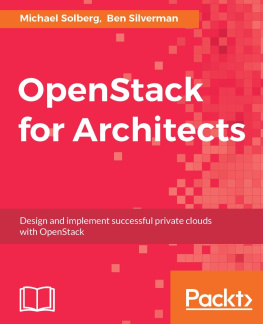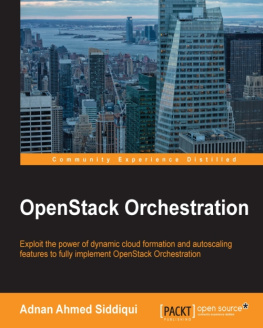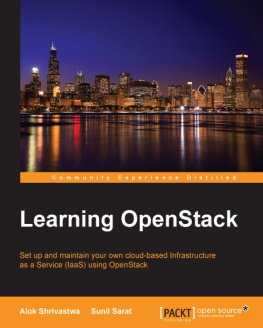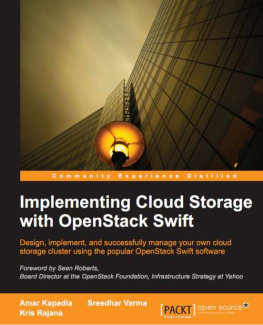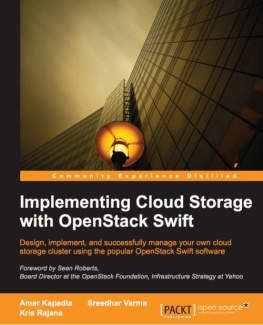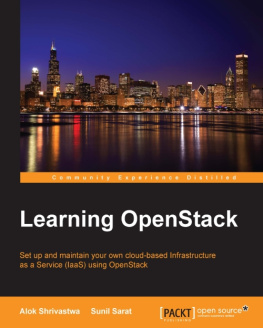CONTENTS
List of Illustrations
Guide
Pages
INTRODUCTION
OpenStack is a set of software packages that manage virtualized resources, including computing, networking, and storage. It enables you to create and destroy virtual machines, connect them together with private networks, provide network-based storage, and make them available to the rest of your network and the world. OpenStack provides consistent, uniform API services for all of this, hiding hypervisor and vendor specific details from the applications that are using the APIs. It also provides a user interface, built on top of the same APIs, that allows users to see and manage their virtual resources.
WHO THIS BOOK IS FOR
This book is for application developers that are interested in learning more about OpenStack and how it will transform the application design and development process. It is for someone who is new to the cloud environment, who wants a broad understanding of that environment, as well as a deep enough knowledge to make practical use of OpenStack.
WHAT THIS BOOK COVERS
This book will provide a broad understanding of cloud concepts and how they fit into the life of an application developer. It will drill in deeply to the OpenStack services that are most important to an application developer, and show you how these services will change not only how you deploy applications, but also how you design them. It will provide detailed information on each service, and provide examples of how each service may be used by an application developer.
HOW THIS BOOK IS STRUCTURED
This book was written in two parts. Part 1 provides an overview of OpenStack. The purpose of this part is to lay the groundwork, covering all of the OpenStack technologies and what is most important.
Part 2 takes the reader through developing and deploying applications with OpenStack. In this part you will build an example on top of OpenStack that drills down much deeper on the technologies, provides tips, and helps you learn about OpenStack through the lens of these same technologies.
Here is a list of the chapters:
- Part I: OpenStack Overview
- Chapter 1: Introduction to OpenStack
- Chapter 2: Understanding the OpenStack Ecosystem: Core Projects
- Chapter 3: Understanding the OpenStack Ecosystem: Additional Projects
- Part II: Developing and Deploying Applications with OpenStack
- Chapter 4: Application Development
- Chapter 5: Improving on the Application
- Chapter 6: Deploying the Application
WHAT YOU NEED TO USE THIS BOOK
You should understand the basics of application development - how applications are composed of multiple servers like web servers, application servers, and database servers. You do not need any cloud-specific knowledge, though you should be aware of what virtualization and virtual machines are, and have a basic understanding of networks.
CONVENTIONS
To help you get the most from the text and keep track of whats happening, weve used a number of conventions throughout the book.
Examples that you can download and try out for yourself generally appear in a box like this:
EXAMPLE TITLE
This section gives a brief overview of the example.
Source
This section includes the source code.
Source codeSource codeSource codeOutput
This section lists the output:
Example outputExample outputExample output
NOTENotes indicates notes, tips, hints, tricks, or and asides to the current discussion.
As for styles in the text:
- We highlight new terms and important words when we introduce them.
- We show code within the text like so:
persistence.properties.
SOURCE CODE
As you work through the examples in this book, you may choose either to type in all the code manually, or to use the source code files that accompany the book. All the source code used in this book is available for download at www.wrox.com. Specifically for this book, the code download is on the Download Code tab at:
www.wrox.com/go/openstackcloudappdev
and at:
https://github.com/johnbelamaric/openstack-appdev-book
You can also search for the book at www.wrox.com by ISBN (the ISBN for this book is 978-1-119-19431-6) to find the code. And a complete list of code downloads for all current Wrox books is available at www.wrox.com/dynamic/books/download.aspx.
NoteBecause many books have similar titles, you may find it easiest to search by ISBN; this books ISBN is 978-1-119-19431-6.
Once you download the code, just decompress it with your favorite compression tool. Alternately, you can go to the main Wrox code download page at www.wrox.com/dynamic/books/download.aspx to see the code available for this book and all other Wrox books.
ERRATA
We make every effort to ensure that there are no errors in the text or in the code. However, no one is perfect, and mistakes do occur. If you find an error in one of our books, like a spelling mistake or faulty piece of code, we would be very grateful for your feedback. By sending in errata, you may save another reader hours of frustration, and at the same time, you will be helping us provide even higher quality information.
To find the errata page for this book, go to
www.wrox.com/go/openstackcloudappdev
And click the Errata link. On this page you can view all errata that has been submitted for this book and posted by Wrox editors.
If you dont spot your error on the Book Errata page, go to www.wrox.com/contact/techsupport.shtml and complete the form there to send us the error you have found. Well check the information and, if appropriate, post a message to the books errata page and fix the problem in subsequent editions of the book.
P2P.WROX.COM
For author and peer discussion, join the P2P forums at http://p2p.wrox.com. The forums are a Web-based system for you to post messages relating to Wrox books and related technologies and interact with other readers and technology users. The forums offer a subscription feature to e-mail you topics of interest of your choosing when new posts are made to the forums. Wrox authors, editors, other industry experts, and your fellow readers are present on these forums.
At http://p2p.wrox.com, you will find a number of different forums that will help you, not only as you read this book, but also as you develop your own applications. To join the forums, just follow these steps:
- Go to http://p2p.wrox.com and click the Register link.
- Read the terms of use and click Agree.
- Complete the required information to join, as well as any optional information you wish to provide, and click Submit.
- You will receive an e-mail with information describing how to verify your account and complete the joining process.
NOTEYou can read messages in the forums without joining P2P, but in order to post your own messages, you must join.
Once you join, you can post new messages and respond to messages other users post. You can read messages at any time on the Web. If you would like to have new messages from a particular forum e-mailed to you, click the Subscribe to this Forum icon by the forum name in the forum listing.
For more information about how to use the Wrox P2P, be sure to read the P2P FAQs for answers to questions about how the forum software works, as well as many common questions specific to P2P and Wrox books. To read the FAQs, click the FAQ link on any P2P page.


